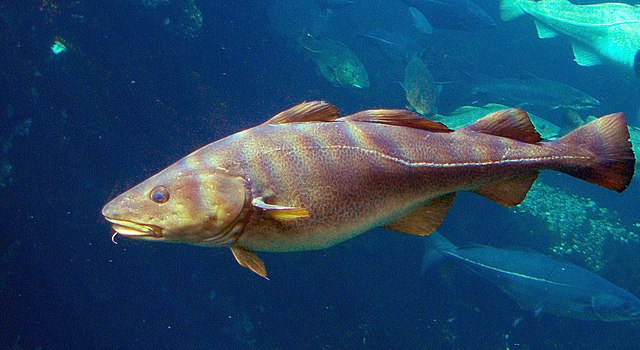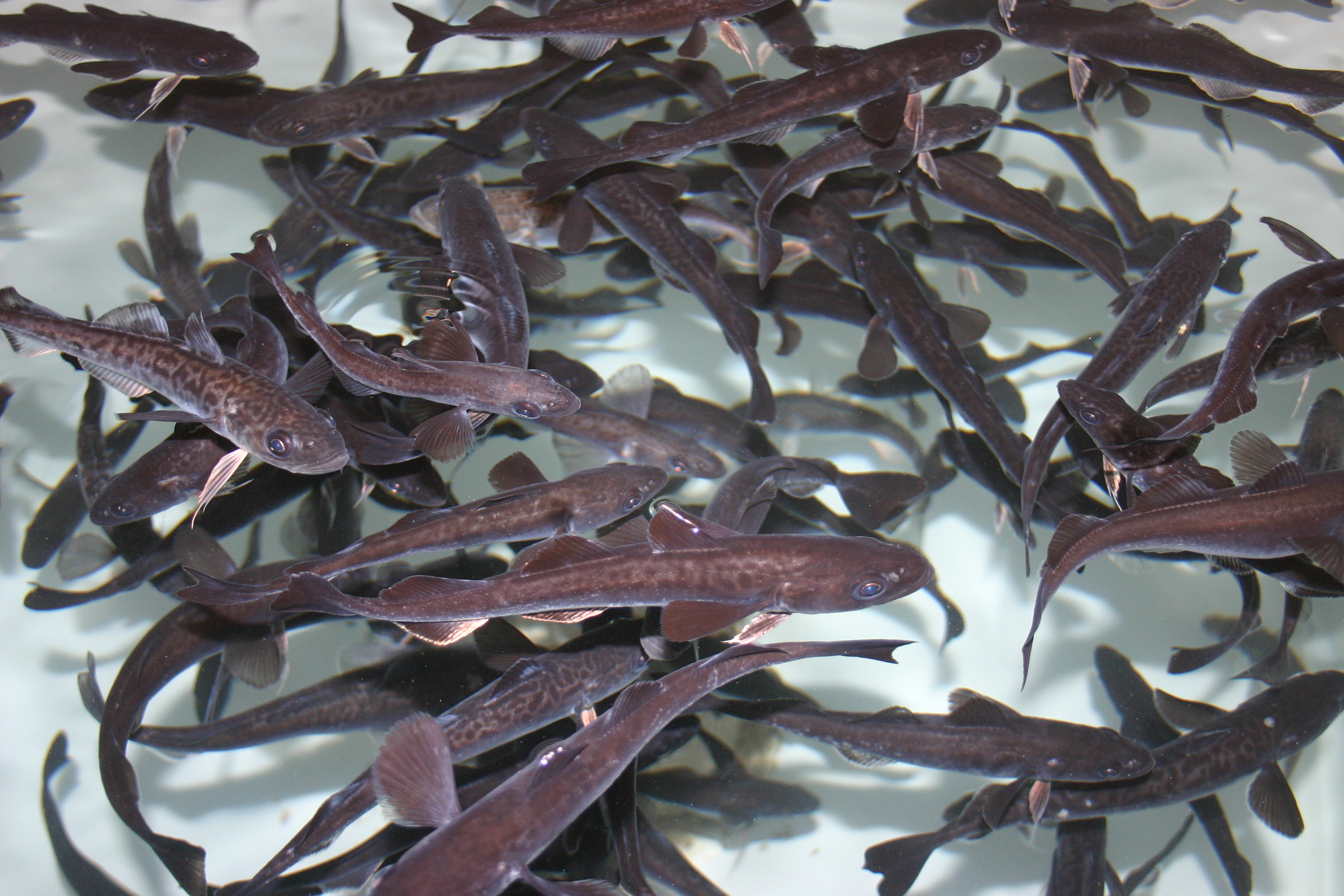Cod fish are a popular and important commercial fish species that belong to the Gadidae family. There are several types of cod fish, and they vary in size and weight.
In this article, we will rank eight types of cod fish by size, from the largest to the smallest. It’s worth noting that some fish commonly known as cod are unrelated to Gadus, and the term “cod” can refer to all members of the genus Gadus.
You are reading: 8 Types Of Cod Fish Ranked By Size

8 Types Of Cod Fish Ranked By Size
Pacific Cod (Gadus macrocephalus)
Pacific cod (Gadus macrocephalus) is a species of ray-finned fish in the family Gadidae. It is a bottom-dwelling fish found in the northern Pacific Ocean, mainly on the continental shelf and upper slopes, to depths of about 900 m (3,000 ft).
Pacific cod can grow up to a length of a meter or so and is found in large schools. They are also known as gray cod because of their color—they’re brown or grayish with dark spots or patterns on the sides and a paler belly.
Pacific cod have a long chin barbell (a whisker-like organ near the mouth, like on a catfish) and dusky fins with white edges. They can live for 20 years or less and can grow up to 6 feet in length.
Females are able to reproduce when they’re 4 or 5 years old, when they are between 1.6 and 1.9 feet long. Pacific cod is an important commercial food species and is also known as gray cod or grey cod, and grayfish or greyfish.
Atlantic Cod (Gadus morhua)
Atlantic cod (Gadus morhua) is a benthopelagic fish of the family Gadidae, widely consumed by humans. It is commonly known as cod or codling and is one of three cod species in the genus Gadus along with Pacific cod and Greenland cod.
Atlantic cod can be found along the eastern and northern coasts of North America, along the coasts of Greenland, and from the Bay of Biscay north to the Arctic. They are heavy-bodied with a large head, blunt snout, and a distinct barbel (a whisker-like organ, like on a catfish) under the lower jaw.
Their coloring varies, ranging from light yellowish-green to red and olive, usually with darker speckles on the head, fins, tail, and body.
Atlantic cod can grow up to 6 feet in length and weigh up to 200 pounds. They are usually found in deeper, colder waters and form schools during the day, swimming about 30-80 m above the bottom, dispersing at night to feed.
Cod are highly prized by recreational fishermen and are commonly harvested by anglers using lures or bait. Regulations include minimum fish sizes, possession limits, and closed seasons.
Black Cod (Sablefish, Butterfish)

Read more : The Top 8 Slowest Animals In The World
Black cod, also known as sablefish and butterfish, is a species of fish found in the North Pacific Ocean. It is a fatty fish with a velvety texture and buttery flavor.
Black cod is not a member of the cod family, nor is it the true butterfish. It is of the family Anoplopomatidae, which is confined to the icy waters off the Pacific Northwest.
Black cod is a popular fish in the culinary world due to its rich and buttery flavor. It is commonly used in Japanese cuisine, where it is known as gindara.
Black cod can be found in muddy sea beds in the North Pacific Ocean at depths of 300 to 2,700 m (980 to 8,860 ft). It is a deep-sea fish that can grow up to 3 feet long and weigh up to 40 pounds.
Black cod is usually sold in portions and is often paired with a miso marinade. It is a sustainable seafood choice and is ranked as a “Best Choice” by the Monterey Bay Aquarium Seafood Watch.
Lingcod
Lingcod (Ophiodon elongatus) is a fish species that belongs to the greenling family Hexagrammidae. It is the only extant member of the genus Ophiodon, and a slightly larger, extinct species, Ophiodon ozymandias, is known from fossils from the Late Miocene of Southern California.
Lingcod is native to the North American west coast from Shumagin Islands in the Gulf of Alaska to Baja California, Mexico. They can grow up to 152 centimeters (60 inches) in length and weigh up to 59 kilograms (130 lb).
Lingcod are solitary, benthic fish and spend most of their time resting within holes or crevices amongst rocks. They are characterized by a large mouth with 18 sharp teeth and are voracious predators.
Lingcod are sought for sport and food, and their flesh is white with a mild flavor, high in protein, minerals, vitamins, and omega-3 fatty acids. Lingcod are taken in subsistence, commercial, and recreational fisheries.
Eucla Cod
Eucla cod (Euclichthys polynemus) is a deepwater marine fish belonging to the cod order (Gadiformes) and is the only species currently classified in the family Euclichthyidae. It is named after the town of Eucla, Western Australia, in whose coastal waters it is found. Eucla cod has a long and tapering body, a large mouth, and no chin barbel.
It has two nearly contiguous dorsal fins; the first is short based and high, and the second is long-based, extending to the base of the caudal fin. Eucla cod may grow up to 35 cm (14 in) and has been found in the Tasman Sea, around Australia from Queensland to the north Western Australian shelf, and off the New Zealand shelf at depths of 250 to 920 m.
Arctic Cod
Arctic cod (Boreogadus saida) is a fish species of the cod family Gadidae, related to the true cod. It is also known as polar cod. Arctic cod is a highly abundant, trophically important pelagic fish species inhabiting Arctic and sub-Arctic marine ecosystems. Here are some key facts about Arctic cod:
– Arctic cod is a small fish species, growing up to 25 cm (10 in) in length.
– It has a circumpolar distribution and is the most abundant planktivorous fish in the Arctic.
– Arctic cod is a vital food source for many marine mammals, birds, and fish species in the Arctic.
– It is a cold-water fish species that lives in extremely cold water temperatures and has adapted to the cold.
– Arctic cod larvae must be in 3°C to hatch normally, and a rise in ocean temperatures can easily lead to phenotypic changes of this cod species.
– Global warming has caused an increase in ocean temperatures of the Arctic Ocean, which can threaten the population of Arctic cod.
– Arctic cod is widespread and abundant in arctic regions, occurring farther north than any other fish species.
Overall, Arctic cod is an important fish species in the Arctic ecosystem and plays a crucial role in the food web.
Pelagic Cod

Pelagic cod is a small deepwater fish found in the Southern Ocean. It is one of only two species currently classified in the family Melanonidae, the other being the arrowtail, Melanonus zugmayeri.
Pelagic cod is found in subantarctic and temperate waters, occasionally being caught in the tropics. It may be found at depths between 150 and 3600 m. Pelagic cod is from the order Gadiformes, related to true cods. It may grow up to 19 cm in length and has no commercial value.
Pelagic fish inhabit the water column, not near the bottom or the shore, of coasts, open oceans, and lakes. Pelagic fish can be categorized as coastal and oceanic fish, based on the depth of the water they inhabit.
Coastal pelagic fish inhabit sunlit waters up to about 655 feet deep, typically above the continental shelf. Oceanic pelagic fish typically inhabit waters below the continental shelf.
Tadpole Cod
Tadpole cod (Salilota australis), also known as Patagonian cod or tadpole codling, is a species of morid cod found in the waters around the southern tip of South America and the Falkland Islands. Here are some key facts about tadpole cod:
– Tadpole cod is a small fish species, growing up to 30 cm (12 in) in length.
– It has a uniform brown color and fins.
– Tadpole cod has a small variably shaped patch of teeth on the head of vomer and a ventral light organ.
– It is a demersal fish species, living near or on the bottom of the ocean.
– Tadpole cod is a commercially important fish species in the southern tip of South America.
– It is also used for human consumption and is considered a delicacy in some regions.
– Tadpole cod is a slow-growing species with a lifespan of up to 20 years.
– The embryonic development of tadpole cod has been studied in scientific research.
Overall, tadpole cod is a small but commercially important fish species found in the southern tip of South America and the Falkland Islands.
FAQS
1. What is cod fish?
Cod fish is a popular and important commercial fish species that belongs to the Gadidae family. It is a bottom-dwelling fish found in the northern Pacific and Atlantic Oceans.
2. What are the types of cod fish ranked by size?
Here are the types of cod fish ranked by size, from the largest to the smallest:
– Pacific Cod
– Atlantic Cod
– Black Cod (Sablefish, Butterfish)
– Lingcod
– Eucla Cod
– Arctic Cod
– Pelagic Cod
– Tadpole Cod
3. What is the largest type of cod fish?
The largest type of cod fish is the Atlantic Cod, which can grow up to 6.56 feet in length.
4. What is the smallest type of cod fish?
The smallest type of cod fish is the Tadpole Cod, which can grow up to 7.1 inches in length.
5. What is Black Cod?
Read more : The Top 8 Slowest Animals In The World
Black cod, also known as sablefish and butterfish, is a species of fish found in the North Pacific Ocean. It is a fatty fish with a velvety texture and buttery flavor.
6. What is Arctic Cod?
Arctic cod is a fish species of the cod family Gadidae, related to the true cod. It is a small fish species, growing up to 25 cm in length, and is highly abundant in Arctic and sub-Arctic marine ecosystems.
7. What is Lingcod?
Lingcod is a fish species that belongs to the greenling family Hexagrammidae. It is a solitary, benthic fish and spend most of their time resting within holes or crevices amongst rocks.
8. What is Eucla Cod?
Eucla cod is a deepwater marine fish belonging to the cod order (Gadiformes) and is the only species currently classified in the family Euclichthyidae. It has a long and tapering body, a large mouth, and no chin barbel.
Source: https://petstutorial.com
Category: Animals










